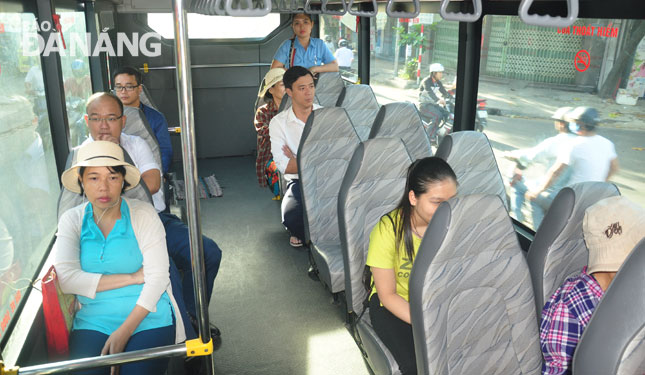Convenience and effectiveness of bus transport service
Over the past 2 years, Da Nang has seen many positive changes in the public transportation sector with growing number of passengers. The effective operation of the existing bus routes has helped to develop a high-quality public transport service for local residents, hereby encouraging locals to use public transport services rather than their personal vehicles with the aim of easing traffic congestion.
 |
| Passengers on board a subsidised intra-city bus |
Currently, a total of 14 bus routes are operating in the city. They are 6 bus routes between Da Nang and Quang Nam Province, 5 intra-city bus routes with subsidised fares, 1 Toyota Mobility Foundation (TMF)- funded intra-city bus route, and 2 Coco Bus Tour routes, all of which use a total of 190 buses.
Many routes allow easier public access to such venues as hospitals, universities, junior colleges, professional secondary schools, industrial parks, and urban areas across the city.
According to the Da Nang Traffic Lights and Public Transport Management Centre (DATRAMAC), the first half of this year saw a sum of 1.5 million bus passengers, up 40% against the same period last year, and this is a positive sign in promoting the habit of travelling by bus among local residents and visitors.
Mr Le Tu Trinh, a public servant working at the municipal Administrative Centre, highly appreciated the usefulness and convenience of bus service. In reality, travelling by bus is less stressful and far cheaper than driving, especially with gas prices on the rise.
Under the city-approved subsidy programme, the fare is only 5,000 VND per passenger per trip. In addition, a monthly pass for 45,000 VND is now available for prioritised commuters, and 90,000 VND for unprioritised ones. These beneficiaries are identified in line with the city’s regulation. Fare exemptions are being offered to Vietnamese Heroic Mothers, the disabled, the elderly or the poor, students and pupils in the city, plus workers in local industrial parks.
In addition, there are much lower passenger fatality rates than travelling by personal vehicle does.
To date, all of the buses operating in the city have been fully equipped with global positioning system (GPS) under the instructions of the Ministry of Transport. The installation of GPS in buses aims to monitor the service quality, and detect bus routes-related violations, including exceeding the speed limits, overtaking recklessly, crossing red light, not stopping at bus stops, and picking up and dropping off passengers at prohibited locations.
According to Mr Le Van Trung, the Director of the municipal Transport Department, 6 new intra-city bus routes, utilising a total of new 40-seater buses and travelling through some local suburb areas, will be launched in the coming time.
These new routes are the former Han River Port - Hoa Tien Commune; the Inter-provincial Coach Station - the Marble Mountains Tourism area; the Inter-provincial Coach Station - Tho Quang; Kim Lien - the Viet Nam-South Korea Friendship IT Junior College; the former Han River Port - the Hoa Vang District Administration Centre; and the 29 March Park - the Da Nang Hi-tech Park.
In particular, an app for public bus routes (DanaBus) that can be downloaded from the Apple and Google Play stores has proved popular with bus passengers. Using the app, visitors and commuters can easily search for the correct bus service and route in the city.
With regard to the city’s long-term public transport network development plans, in addition to the promotion of the existing bus routes, focus will be on developing Bus Rapid Transit (BRT) ones, tourists busses and an urban railway system in the city’s inner areas in an attempt to relieve the current traffic congestion.




